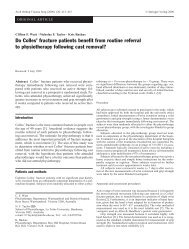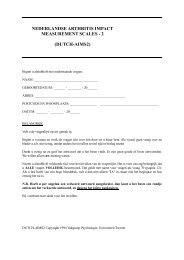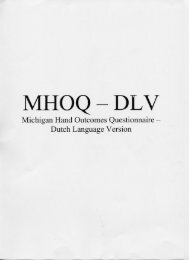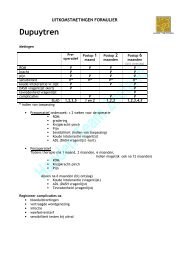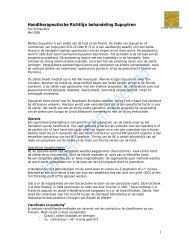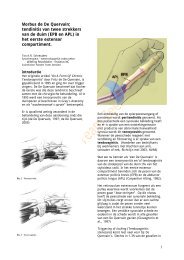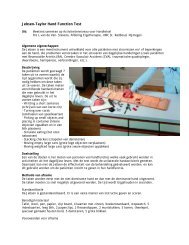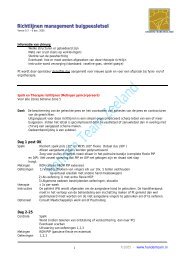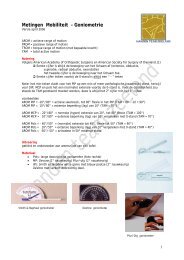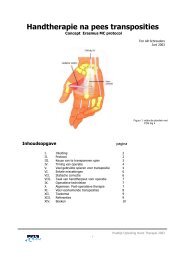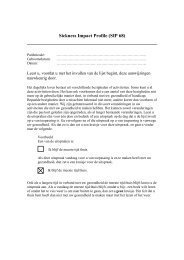Muscle strength measurements of the Hand - Handen Team Zeeland
Muscle strength measurements of the Hand - Handen Team Zeeland
Muscle strength measurements of the Hand - Handen Team Zeeland
Create successful ePaper yourself
Turn your PDF publications into a flip-book with our unique Google optimized e-Paper software.
Ton A.R. Schreuders, JW Brandsma, HJ Stam<br />
innervated. The origin for <strong>the</strong> FPB is <strong>the</strong><br />
flexor retinaculum and <strong>the</strong> trapezium,<br />
respectively. Comparable to <strong>the</strong> APB, <strong>the</strong><br />
FPB inserts into <strong>the</strong> extensor tendon and<br />
<strong>the</strong> lateral sesamoid bone, and assists in<br />
extension <strong>of</strong> <strong>the</strong> IP joint <strong>of</strong> <strong>the</strong> thumb.<br />
The proximal fibers <strong>of</strong> <strong>the</strong> FPB are<br />
continuous with <strong>the</strong> OP, <strong>the</strong>refore, both act<br />
on <strong>the</strong> CMC joint <strong>of</strong> <strong>the</strong> thumb and flex <strong>the</strong><br />
metacarpal. The major effect <strong>of</strong> <strong>the</strong> FPB is<br />
in sequence with <strong>the</strong> AP, in that both flex<br />
<strong>the</strong> MCP <strong>of</strong> <strong>the</strong> thumb, although <strong>the</strong> FPB<br />
pronates and <strong>the</strong> AP supinates <strong>the</strong><br />
thumb. 4<br />
2.3.2 Pathokinesiology (paralyses,<br />
consequences for ADL/ prehension)<br />
Isolated weakness <strong>of</strong> <strong>the</strong> FPB is<br />
difficult to assess, not only because <strong>of</strong> <strong>the</strong><br />
variations in innervation, but mainly<br />
because <strong>of</strong> all <strong>the</strong> synergists in flexion <strong>of</strong><br />
<strong>the</strong> MCP joint and sometimes <strong>the</strong> lack <strong>of</strong><br />
mobility in <strong>the</strong> MCP joint <strong>of</strong> <strong>the</strong> thumb.<br />
Isolated loss <strong>of</strong> <strong>the</strong> FPB might go<br />
unnoticed, but loss in combination with<br />
loss <strong>of</strong> <strong>the</strong> AP, e.g. in ulnar nerve palsy,<br />
will cause significant loss <strong>of</strong> pinch <strong>strength</strong><br />
(see AP).<br />
Positioning <strong>of</strong> <strong>the</strong> thumb in pinch<br />
activities is a median nerve muscle<br />
function, but <strong>the</strong> <strong>strength</strong> <strong>of</strong> <strong>the</strong> pinch grip<br />
is derived from <strong>the</strong> ulnar nerve innervated<br />
muscles.<br />
2.3.3. Assessment possibilities (manual<br />
and instrumental)<br />
In MMST <strong>the</strong> <strong>strength</strong> <strong>of</strong> <strong>the</strong> FPB is<br />
evaluated by <strong>the</strong> assessment <strong>of</strong> flexion at<br />
<strong>the</strong> MCP joint <strong>of</strong> <strong>the</strong> thumb without flexion<br />
<strong>of</strong> <strong>the</strong> IP joint, which is <strong>the</strong> FPL action. A<br />
<strong>strength</strong> test aiming to diminish <strong>the</strong> FPL<br />
action has been studied but without<br />
convincing results. 77<br />
Measurements <strong>of</strong> <strong>the</strong> <strong>strength</strong> <strong>of</strong><br />
<strong>the</strong> FPB with pinch dynamometers in<br />
isolation is not possible. In <strong>the</strong><br />
dynamometry <strong>of</strong> <strong>the</strong> pinch grip, <strong>the</strong> FPB<br />
toge<strong>the</strong>r with <strong>the</strong> AP contribute<br />
significantly to pinch <strong>strength</strong>.<br />
2.3.4. Therapy principles (prevention <strong>of</strong><br />
complications, exercises for <strong>strength</strong>ening)<br />
All pinch activities can be<br />
exercised, in which <strong>the</strong> tendency to<br />
(hyper-) extend <strong>the</strong> MCP joint is a sign <strong>of</strong><br />
improper activation <strong>of</strong> <strong>the</strong> FPB and AP and<br />
needs to be corrected. A pinch whereby<br />
<strong>the</strong> MCP and IP joint is slightly flexed is<br />
also advantageous regarding <strong>the</strong> optimum<br />
(mid) position <strong>of</strong> <strong>the</strong> sarcomers <strong>of</strong> <strong>the</strong><br />
intrinsic muscles <strong>of</strong> <strong>the</strong> thumb and for least<br />
tension on <strong>the</strong> s<strong>of</strong>t tissues (ligaments,<br />
volar plate) <strong>of</strong> <strong>the</strong> thumb joints.<br />
2.4 Adductor Pollicis (AP)<br />
2.4.1 Functional anatomy<br />
The ulnar innervated AP is a<br />
fanshaped muscle with two heads: an<br />
oblique part with its origin at <strong>the</strong> 2 nd and 3 rd<br />
metacarpals and <strong>the</strong> transverse part with<br />
its origin at <strong>the</strong> anterior surface <strong>of</strong> <strong>the</strong> 3 rd<br />
metacarpal. The insertion <strong>of</strong> both heads is<br />
into proximal phalanx <strong>of</strong> <strong>the</strong> thumb and <strong>the</strong><br />
sesamoid bone.<br />
It is <strong>the</strong> most volar muscle in <strong>the</strong><br />
thumb web, making atrophy visible in <strong>the</strong><br />
palm <strong>of</strong> <strong>the</strong> hand. Of all <strong>the</strong> intrinsic<br />
muscles working on <strong>the</strong> thumb, <strong>the</strong> AP,<br />
working toge<strong>the</strong>r with <strong>the</strong> FPB, has <strong>the</strong><br />
largest flexion moment arm at <strong>the</strong> CMC<br />
joint. Therefore, <strong>the</strong> AP, toge<strong>the</strong>r with <strong>the</strong><br />
1 DI, are <strong>the</strong> most important pinching<br />
muscle <strong>of</strong> <strong>the</strong> thumb, while o<strong>the</strong>r thumb<br />
muscles are just positioners and<br />
synergists. 4 p 229 The synergists for<br />
adduction <strong>of</strong> <strong>the</strong> thumb are EPL, FPL and<br />
<strong>the</strong> first dorsal interosseus. 78<br />
2.4.2 Pathokinesiology (paralyses,<br />
consequences for prehension/ADL,<br />
shortening)<br />
Direct lesions <strong>of</strong> <strong>the</strong> AP sometimes<br />
occur after injuries into <strong>the</strong> thumb web,<br />
e.g. knife wounds. Paralyses <strong>of</strong> <strong>the</strong> AP<br />
usually occur after ulnar nerve lesion and<br />
<strong>the</strong>refore <strong>the</strong>re is also weakness <strong>of</strong> <strong>the</strong><br />
o<strong>the</strong>r important muscle for pinch; <strong>the</strong> 1 DI.<br />
In ulnar palsy <strong>the</strong>re may be enough<br />
median nerve innervated FPB to position<br />
<strong>the</strong> thumb for pinch, but when power is<br />
needed, <strong>the</strong> diminished AP <strong>strength</strong><br />
usually results in hyperflexion <strong>of</strong> <strong>the</strong> IP<br />
joint <strong>of</strong> <strong>the</strong> thumb (Froment’s sign) and<br />
sometimes in hyperextension <strong>of</strong> <strong>the</strong> MCP<br />
joint (Jeanne’s sign).<br />
4 p 54<br />
A patient who is bedridden for a<br />
prolonged time with little activity <strong>of</strong> <strong>the</strong><br />
hand (coma etc.) can develop a thumb<br />
web contracture due to shortening <strong>of</strong> <strong>the</strong><br />
14



